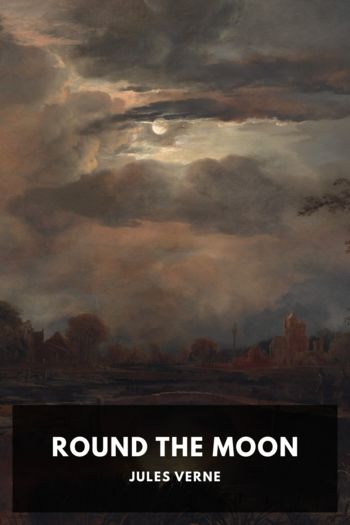Round the Moon by Jules Verne (read aloud txt) 📕

- Author: Jules Verne
Book online «Round the Moon by Jules Verne (read aloud txt) 📕». Author Jules Verne
By Jules Verne.
Translated by Ward, Lock & Co.
Table of Contents Titlepage Imprint Preliminary Chapter I: From 10:20 P.M. to 10:47 P.M. II: The First Half-Hour III: Taking Possession IV: A Little Algebra V: The Temperature of Space VI: Questions and Answers VII: A Moment of Intoxication VIII: At Seventy-Eight Thousand One Hundred and Fourteen Leagues IX: The Consequences of Deviation X: The Observers of the Moon XI: Imagination and Reality XII: Orographical Details XIII: Lunar Landscapes XIV: A Night of Three Hundred and Fifty-Four Hours and a Half XV: Hyperbola or Parabola XVI: The Southern Hemisphere XVII: Tycho XVIII: Grave Questions XIX: A Struggle with the Impossible XX: The Soundings of the Susquehanna XXI: J. T. Maston Called In XXII: Picked Up XXIII: The End Colophon Uncopyright ImprintThis ebook is the product of many hours of hard work by volunteers for Standard Ebooks, and builds on the hard work of other literature lovers made possible by the public domain.
This particular ebook is based on a transcription produced for Project Gutenberg .
The writing and artwork within are believed to be in the U.S. public domain, and Standard Ebooks releases this ebook edition under the terms in the CC0 1.0 Universal Public Domain Dedication. For full license information, see the Uncopyright at the end of this ebook.
Standard Ebooks is a volunteer-driven project that produces ebook editions of public domain literature using modern typography, technology, and editorial standards, and distributes them free of cost. You can download this and other ebooks carefully produced for true book lovers at standardebooks.org.
Preliminary Chapter Containing a Short Account of the First Part of This Work to Serve as Preface to the SecondDuring the course of the year 186- the entire world was singularly excited by a scientific experiment without precedent in the annals of science. The members of the Gun Club, a circle of artillerymen established at Baltimore after the American war, had the idea of putting themselves in communication with the moon—yes, with the moon—by sending a bullet to her. Their president, Barbicane, the promoter of the enterprise, having consulted the astronomers of the Cambridge Observatory on this subject, took all the precautions necessary for the success of the extraordinary enterprise, declared practicable by the majority of competent people. After having solicited a public subscription which produced nearly 30,000,000 of francs, it began its gigantic labours.
According to the plan drawn up by the members of the observatory, the cannon destined to hurl the projectile was to be set up in some country situated between the 0° and 28° of north or south latitude in order to aim at the moon at the zenith. The bullet was to be endowed with an initial velocity of 12,000 yards a second. Hurled on the 1st of December at thirteen minutes and twenty seconds to eleven in the evening, it was to get to the moon four days after its departure on the 5th of December at midnight precisely, at the very instant she would be at her perigee—that is to say, nearest to the earth, or at exactly 86,410 leagues’ distance.
The principal members of the Gun Club, the president, Barbicane, Major Elphinstone, the secretary, J. T. Maston, and other savants, held several meetings, in which the form and composition of the bullet were discussed, as well as the disposition and nature of the cannon, and the quality and quantity of the powder to be employed. It was decided—1, that the projectile should be an obus of aluminium, with a diameter of 800 inches; its sides were to be 12 inches thick, and it was to weigh 19,250 lbs.; 2, that the cannon should be a cast-iron Columbiad 900 feet long, and should be cast at once in the ground; 3, that the charge should consist of 400,000 lbs. of guncotton, which, by developing 6,000,000,000 litres of gas under the projectile, would carry it easily towards the Queen of Night.
These questions settled, President Barbicane, aided by the engineer, Murchison, chose a site in Florida in 27° 7′ north lat. and 5° 7′ west long. It was there that after marvels of labour the Columbiad was cast quite successfully.
Things were at that pass when an incident occurred which increased the interest attached to this great enterprise.
A Frenchman, a regular Parisian, an artist as witty as audacious, asked leave to shut himself up in the bullet in order to reach the moon and make a survey of the terrestrial satellite. This intrepid adventurer’s name was Michel Ardan. He arrived in America, was received with enthusiasm, held meetings, was carried in triumph, reconciled President Barbicane to his mortal enemy, Captain Nicholl, and in pledge of the reconciliation he persuaded them to embark with him in the projectile.
The proposition was accepted. The form of the bullet was changed. It became cylindro-conical. They furnished this species of aerial compartment with powerful springs and breakable partitions to break the departing shock. It was filled with provisions for one year, water for some months, and gas for some days. An automatic apparatus made and gave out the air necessary for the respiration of the three travellers. At the same time the Gun Club had a gigantic telescope set up on one of the highest summits of the Rocky Mountains, through which the projectile could be followed during its journey through space. Everything was then ready.
On the 30th of November, at the time fixed, amidst an extraordinary concourse of spectators, the departure took place, and for the first time three human beings left the terrestrial globe for the interplanetary regions with almost the certainty of reaching their goal.
These audacious travellers, Michel Ardan, President Barbicane, and Captain Nicholl were





Comments (0)